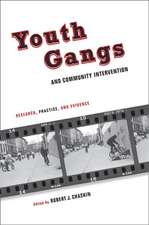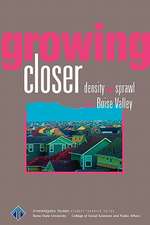Integrating the Inner City: The Promise and Perils of Mixed-Income Public Housing Transformation
Autor Robert J. Chaskin, Mark L. Josephen Limba Engleză Paperback – 25 ian 2017
For many years Chicago’s looming large-scale housing projects defined the city, and their demolition and redevelopment—via the Chicago Housing Authority’s Plan for Transformation—has been perhaps the most startling change in the city’s urban landscape in the last twenty years. The Plan, which reflects a broader policy effort to remake public housing in cities across the country, seeks to deconcentrate poverty by transforming high-poverty public housing complexes into mixed-income developments and thereby integrating once-isolated public housing residents into the social and economic fabric of the city. But is the Plan an ambitious example of urban regeneration or a not-so-veiled effort at gentrification?
In the most thorough examination of mixed-income public housing redevelopment to date, Robert J. Chaskin and Mark L. Joseph draw on five years of field research, in-depth interviews, and volumes of data to demonstrate that while considerable progress has been made in transforming the complexes physically, the integrationist goals of the policy have not been met. They provide a highly textured investigation into what it takes to design, finance, build, and populate a mixed-income development, and they illuminate the many challenges and limitations of the policy as a solution to urban poverty. Timely and relevant, Chaskin and Joseph’s findings raise concerns about the increased privatization of housing for the poor while providing a wide range of recommendations for a better way forward.
In the most thorough examination of mixed-income public housing redevelopment to date, Robert J. Chaskin and Mark L. Joseph draw on five years of field research, in-depth interviews, and volumes of data to demonstrate that while considerable progress has been made in transforming the complexes physically, the integrationist goals of the policy have not been met. They provide a highly textured investigation into what it takes to design, finance, build, and populate a mixed-income development, and they illuminate the many challenges and limitations of the policy as a solution to urban poverty. Timely and relevant, Chaskin and Joseph’s findings raise concerns about the increased privatization of housing for the poor while providing a wide range of recommendations for a better way forward.
| Toate formatele și edițiile | Preț | Express |
|---|---|---|
| Paperback (1) | 257.60 lei 6-8 săpt. | |
| University of Chicago Press – 25 ian 2017 | 257.60 lei 6-8 săpt. | |
| Hardback (1) | 312.59 lei 6-8 săpt. | |
| University of Chicago Press – 13 noi 2015 | 312.59 lei 6-8 săpt. |
Preț: 257.60 lei
Nou
Puncte Express: 386
Preț estimativ în valută:
49.29€ • 51.60$ • 40.79£
49.29€ • 51.60$ • 40.79£
Carte tipărită la comandă
Livrare economică 05-19 aprilie
Preluare comenzi: 021 569.72.76
Specificații
ISBN-13: 9780226478197
ISBN-10: 022647819X
Pagini: 363
Ilustrații: 18 halftones
Dimensiuni: 152 x 229 x 25 mm
Greutate: 0.45 kg
Ediția:1
Editura: University of Chicago Press
Colecția University of Chicago Press
ISBN-10: 022647819X
Pagini: 363
Ilustrații: 18 halftones
Dimensiuni: 152 x 229 x 25 mm
Greutate: 0.45 kg
Ediția:1
Editura: University of Chicago Press
Colecția University of Chicago Press
Notă biografică
Robert J. Chaskin is professor and deputy dean at the University of Chicago School of Social Service Administration and director of the University of Chicago Urban Network. He is the author or editor of several books, including, most recently, Youth Gangs and Community Intervention. Mark L. Joseph is associate professor in the Jack, Joseph and Morton Mandel School of Applied Social Sciences at Case Western Reserve University and director of the National Initiative on Mixed-Income Communities. He is coauthor of Voices from the Field: Learning from Comprehensive Community Initiatives.
Cuprins
Prologue
Part One
1 Concentrated Poverty, Public Housing Reform, and the Promise of Integration
2 Theoretical Assumptions and Policy Orientations
3 Mixed-Income Development in Context: Urban Poverty, Community Development, and the Transformation of Public Housing
Part Two
4 Setting the Stage: The Neighborhood and Development Site Contexts
5 From Physical Transformation to Re-Creating Community: Development Strategies and Inputs
6 Does Social “Mix” Lead to Social Mixing? Emergent Community and the Nature of Social Interaction
7 Space, Place, and Social Control: Surveillance, Regulation, and Contested Community
8 Development, Neighborhood, and Civic Life: The Question of Broader Integration
9 The Promise and Perils of Mixed-Income Public Housing Transformation
Acknowledgments
Appendix: Methods and Data
Notes
References
Index
Part One
1 Concentrated Poverty, Public Housing Reform, and the Promise of Integration
2 Theoretical Assumptions and Policy Orientations
3 Mixed-Income Development in Context: Urban Poverty, Community Development, and the Transformation of Public Housing
Part Two
4 Setting the Stage: The Neighborhood and Development Site Contexts
5 From Physical Transformation to Re-Creating Community: Development Strategies and Inputs
6 Does Social “Mix” Lead to Social Mixing? Emergent Community and the Nature of Social Interaction
7 Space, Place, and Social Control: Surveillance, Regulation, and Contested Community
8 Development, Neighborhood, and Civic Life: The Question of Broader Integration
9 The Promise and Perils of Mixed-Income Public Housing Transformation
Acknowledgments
Appendix: Methods and Data
Notes
References
Index
Recenzii
“Integrating the Inner City is the first serious, empirically based, book-length analysis of mixed-income housing and is destined to become the leading study in its field for years to come. Drawing on exceptional research, Chaskin and Joseph carefully ground the book in theory while providing rich data to support their arguments along the way. Few works have examined life inside public mixed-income communities, making this book a valuable addition that will be highly sought after by the many people concerned with affordable housing.”
“Integrating the Inner City rises above politics, profit-motives, and moralizing and offers a real look at how mixed-income communities are working and not working for the people who live in them. Chaskin and Joseph give us a rigorously empirical account of the translation of theory into practice, and the story is a sobering one. The buildings are new and the streets are safer, but poor residents still experience considerable social stigma and economic fragility. Meticulously researched, accessibly written, and powerfully argued, this book should guide public housing policy and our approach to racial and class integration for decades to come.”
“Chaskin and Joseph’s study of the promises and the limitations of The Chicago Plan for Transformation, the largest attempt at mixed-income public housing reform in the US, reveals a challenge that many urban planners do not foresee—the continued economic and social marginalization of the poor families who gain a place in mixed-income developments. Integrating the Inner City not only combines compelling data, based on six years of in-depth field research, and considerate theoretical arguments to describe and explain the problem of economic and social integration in these developments, it also suggests several positive actions that might be taken to address it. Chaskin and Joseph’s impressive study is a must-read.”
“Clearly written and meticulously researched, the book gives readers a rare inside look at Chicago’s mixed-income developments and, in doing so, powerfully argues that mixed-income redevelopment is not the integrationist solution for curing urban poverty that it is often said to be. . . . Fascinating and timely, a must-read for those concerned with public policy and affordable housing.”
“Chaskin and Joseph explore the nature of social interaction and relationships among residents having different income and racial/ethnic backgrounds, observe tensions between integration and exclusion and poverty and development, argue that these mixed-income communities reproduce marginality and alienation, and conclude that a market-driven approach to public housing reform has led to physical improvements but has not brought major socioeconomic advantages to mixed-income communities. The authors suggest several actions that may contribute to better social integration, social mobility, and communities that are more inclusive. This volume makes an outstanding contribution to public housing policy, community development, and urban studies. Highly recommended.”
“Integrating the Inner City stands out because it does an outstanding job in providing an in-depth and comprehensive look at how mixed-income public housing reform is actually playing out in real places. Six years of fieldwork have produced a stellar product.”
“Integrating the Inner City provides a valuable, yet cautionary, tale about the current zeitgeist in public housing reform. . . . Chaskin and Joseph have produced a highly important work that adds greatly to our understanding of the benefits, limitations, and complex challenges involved in undertaking public housing reform. From a broader perspective, the book’s focus on the role of housing as a platform for poverty reduction is in line with growing academic interest in this topic.”
“An ambitious, provocative book on the subject of what the authors call “contrived” integration. The aim is to expose the complications of an ‘integrationist agenda’—that is, the effort to integrate people of varying incomes in mixed-income housing developments. . . . The authors’ bottom line is that whatever benefits have been garnered—and there have been some—they do not outweigh the costs. The shift to market rate, mixed-income development essentially squandered limited public funds that might have been used to house more people in need.”
“[Chaskin and Joseph's] richly detailed, thoroughly researched work contributes substantially and enduringly to readers interested in urban sociology, urban planning, social inequality, public housing, antipoverty policies, marketplace ideologies, and the application of mixed-methods research to policy analysis.”











